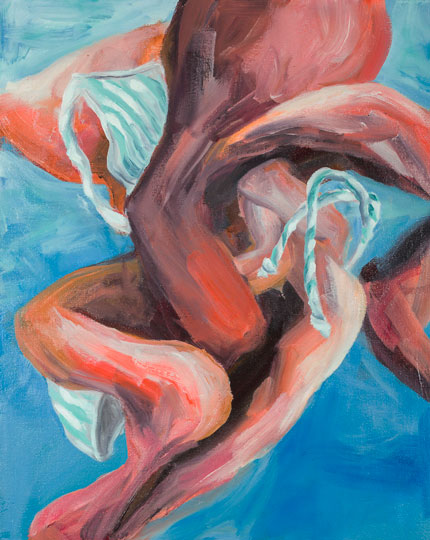Virginia Broersma’s exploitation of wet-on-wet painting is not simply self-indulgent, it is lavish, extravagant, and delirious, amplifying what is already a relatively excessive technique into an over-the-top visual experience, at once ecstatic and excruciating. However much she may delight in the wet-on-wet method or want to show off her chops, Broersma’s principal purpose is clearly to rock the viewer’s world. To some, her paintings overwhelm the critical faculties with eruptive surfaces and sensuous marks. To others, her deep-end plunges into wet-on-wet practice are little short of stomach-churning. Broersma challenges both kinds of viewer: give it up totally to the technique or get a handle on yourself, but there’s no shrugging it off.
In fact, you can’t shrug it off even when Broersma paints a “bad” picture. There were several such grating, dissonant canvases in this latest exhibition, and there were knowingly sour passages in several other works as well. In these places—oddly angled brushstrokes in otherwise brilliantly executed pictures, for instance, or dark figures and objects modeled with a vigorous clumsiness—Broersma slips easily but dramatically from the virtuosic rendering that typifies her approach into something much harsher. Most painters with her skill set would find it almost impossible to compromise such a skill set so deftly and so nastily. But Broersma can—in great part because she needs to.
Broersma is clearly not about the meaning of the picture she’s painting so much as she is the meaning of the way it is painted. Even so, subject matter is no mere armature for her to hang a style on. Like her previous series of self-portraits, her brightly colored pictures of tumbling and cascading forms, which quickly (if never entirely) reveal themselves as body parts, treat the flesh with passionate ambivalence, finding limbs and torsi, skin and meat at once delightful and disgusting. Beholding these piles of sinew immediately inculcates you in the making of choices, however hypothetical: do I consume it or escape it? Do I consume it gustatorily or carnally? Where is the line between sex and food, anyway? Is what I’m fleeing not the presence before me but that very question?
Broersma’s technique, more than her imagery, triggers this inner debate. What she paints may or may not be considered luscious, but she paints it with an imposing lusciousness. She invites us to bite, or kiss, or flee, not her subjects but her paint—or, more accurately, she invites us to embrace her subjects precisely because they cannot be separated from the way they’ve been painted. Is she then extending to us a sense of what it’s like to delight in the act of painting? Not really. She’s extending to us the power of paint itself, a substance whose emphatic facture renders it almost exotic at this moment of digital (that is, flat-screened) ubiquity. Such a conflation of paint and flesh reclaims a tradition that goes back through Soutine, Courbet, Magnasco to Titian and the Venetian School. In our consumerist yet puritanical age, this tradition seems at once perverse and liberating—especially in Broersma’s hands.



